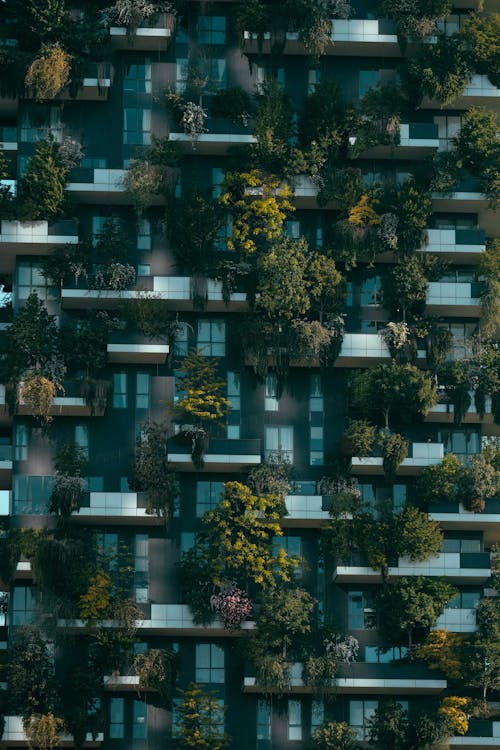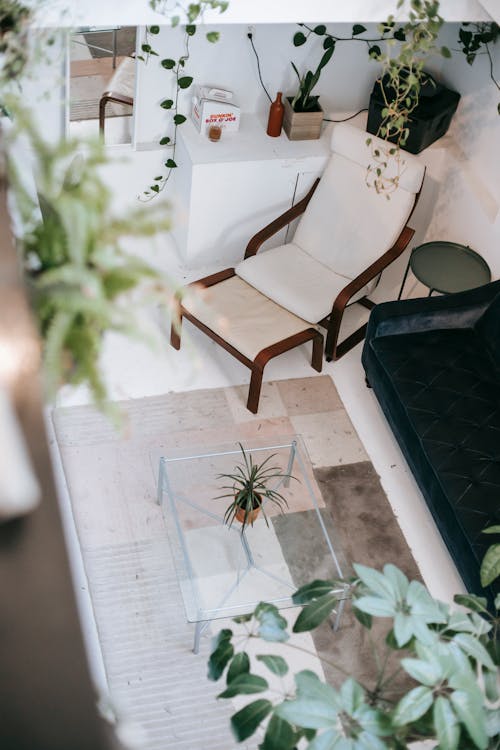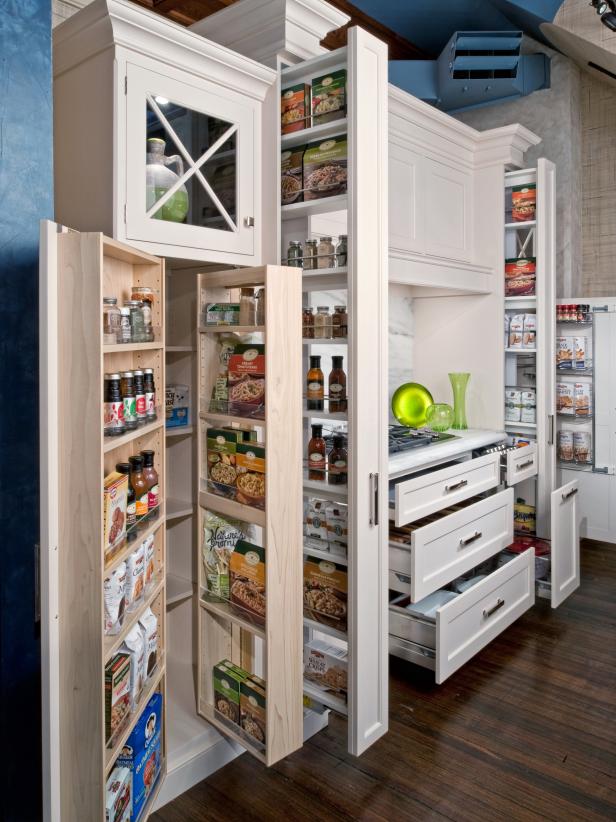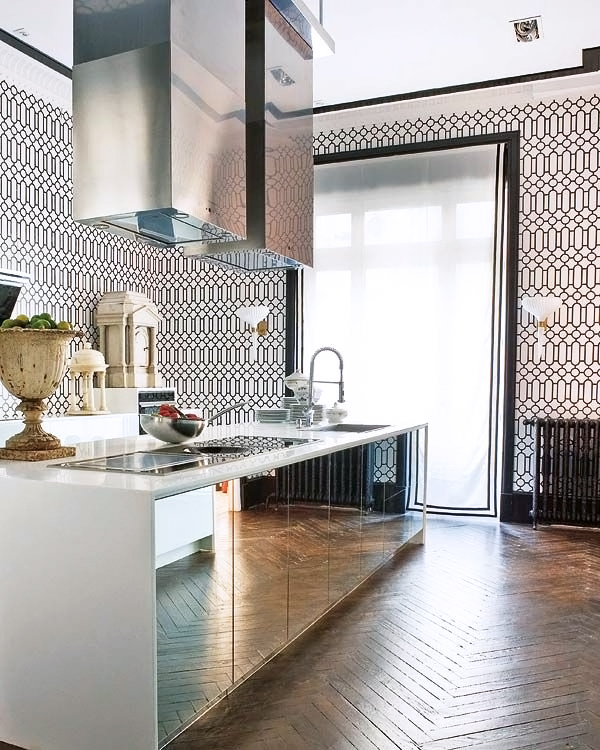Biophilic design is not a new concept – just a new name – to build and design our spaces in a way that integrates with nature and the environment around us.
With the rising rates of urbanization and city density, most of us cannot live closer to nature anymore. While we still ostracize the fauna and flora to the enclosure of parks and to distant forests, they won’t play a significant part in our lives.
So why not bring nature inside our cities and homes?
What is Biophilic Design?
Biophilic Design is more than just adding a little garden or house plant here and there. It means actively integrating nature with the living space, making it a part of the aesthetic and daily life – like we’ve done for thousands of years.
It means adapting our lives and spaces to the environment around us rather than shaping it to our wills.
A great and famous example of this are the beautiful and famous houses of the Greek island of Santorini.

The emblematic white paint that colours many of the buildings in the island comes as a natural cooling solution – since white reflects most of the sunlight. By integrating the environment, they’ve come up with a cheap cooling system that also resulted in a unique and elegant architectural design that would stand as a symbol of the island for decades to come.
That’s what biophilic design is about – working with nature, not despite it.
Biophilic Interior Design
When it comes to designing a biophilic interior, we can either do it by directly incorporating natural elements into the project (plants, running water, sunlight etc.) or by simulating natural shapes and textures.
Sometimes, clients worry they will have to give up practical space or spend their budget on something purely aesthetic. But the whole idea of a biophilic design is to fully incorporate natural elements into daily life.
Sure you might have to give up a piece or two of decor, but the benefits of bringing nature into your life will greatly outweigh the losses. You’ll see below how it’s possible to integrate natural elements with a pretty low budget.
Vertical Garden
This is a nice and modern way to integrate plants into your home – especially when you don’t have a lot of spare space. A vertical garden can help you cool a room and keep the humidity in. Be sure to choose a space with abundant sunlight and plants that don’t need great amounts of water – to keep them from dripping all over the floor.

Another option is to take the vertical garden outside! You could even turn a whole wall of your home into a beautiful and modern way to garden. Outside, it will still help absorb sunlight and cool the interior, while giving you the option of even cultivating edible plants like lettuce!

Biophilic Living Room
What about turning the most social of rooms into the most natural of the house?

Adding plants to the living room is a common choice because of its versatility and low cost. You can find a place for almost any plant in your living room, creating a fresh and pleasant environment for social and family gatherings.
Winter Garden
If you have a bit more land space at your disposal, why not create a little greenhouse connecting to your living room or even somewhere in your garden?

It can provide you with some natural refuge when it’s too cold to stay outside. A winter garden provides you with a meditative space to work or to unwind after a long and stressful day.
Biophilic Urban Design
Biophilic design has a place both inside and outside our homes. By integrating nature into our buildings and infrastructure across the urban space, we can foster improvements on people’s mental and physical health – while addressing environmental problems typical of the urban environment, such as CO2 and noise pollution.

Elements of a Biophilic Design
There are no hard rules on the right way to execute a biophilic design. As nature itself and human needs are multiple and unique, so are the ways of binding them together in a cohesive and practical way.
Our minds will usually go straight to plants when we think of biophilia, but there a number of other ways we can accommodate nature when building:
- Varying acoustics and sound interactions
- Light and Shadow movement and oscillation
- Multiple textures and patterns
- Movement and Dynamism
- Prospect and Refuge (to be able to see all, yet feel safe)
- Transitional Spaces
- Use of Natural Materials
It’s clear that to be truly biophilic, a design needs to integrate nature continuously and as a whole.

Throughout his work, the famous Yale professor Stephen R. Kellert, who researches the connections between humans and nature and ecology, outlines 5 conditions of a biophilic design:
- Biophilic design emphasizes human adaptations to the natural world that over evolutionary time have proven instrumental in advancing people’s health, fitness, and wellbeing. Exposures to nature irrelevant to human productivity and survival exert little impact on human wellbeing and are not effective instances of biophilic design.
- Biophilic design depends on repeated and sustained engagement with nature. An occasional, transient, or isolated experience of nature exerts only superficial and fleeting effects on people, and can even, at times, be at variance with fostering beneficial outcomes.
- Biophilic design requires reinforcing and integrating design interventions that connect with the overall setting or space. The optimal functioning of all organisms depends on immersion within habitats where the various elements comprise a complementary, reinforcing, and interconnected whole. Exposures to nature within a disconnected space – such as an isolated plant or an out of context picture or a natural material at variance with other dominant spatial features – is NOT effective biophilic design.
- Biophilic design fosters emotional attachments to settings and places. By satisfying our inherent inclination to affiliate with nature, biophilic design engenders an emotional attachment to particular spaces and places. These emotional attachments motivate people’s performance and productivity, and prompt us to identify with and sustain the places we inhabit.
- Biophilic design fosters positive and sustained interactions and relationships among people and the natural environment. Humans are a deeply social species whose security and productivity depends on positive interactions within a spatial context. Effective biophilic design fosters connections between people and their environment, enhancing feelings of relationship, and a sense of membership in a meaningful community.
Benefits of a Biophilic Design
As biophilic thought and design become ever more “mainstream”, research is being continuously published on the benefits of this human-nature interaction. Here are some of the most common benefits to pop up amongst researches:
- Reduced levels of stress
- Better mood
- Increased sense of well-being
- Better air quality
- Improved focus and creativity
Can’t wait to turn your home into a natural oasis carefully designed to your needs? Biophilic design is one of our specialties here at House of Cerrelli! Contact us and let us make your dream home come true.
5 Interior Design Ideas for Small Condos
1. Integrated Balcony

If you have a balcony at your disposal, even the smallest of condos can gain a few square feet of usable space if you integrate it correctly into the rest of the apartment. One option is to turn your balcony into a little dining room, adding a small table and a couple of chairs.
This is good especially if you live with only one more person or if you don’t have a lot of people around often. You’ll save on the space of a dining room and can put it to better use.
Or if you want to keep a social space for meals, another idea is to turn the balcony into a little office, saving up space in your bedroom or even an entire room of the apartment.

2. Small Condos Need Light

Both in light and in colour, you want to make your apartment as illuminated as possible. Even though darker tones can make your home feel cozier, they also tend to absorb most of the light and make the space feel somewhat smaller – and that’s no good in an already small condo.
So what you need to do is pick lighter and more neutral palettes to paint and decorate your home. Sure you can use darker tones in the bedroom or in the office, keep social areas like the living room and the kitchen lighter to make the apartment look bigger and airy.
And be sure to pick light drapery to let as much sunlight in as possible!
3. Think of Spaces Rather Than Rooms

Especially if you live in a studio apartment, walls might not be the best option – or not an option at all! – to divide your home adequately. So it might be a good idea to get rid of them and use other options to break the space up.
But let’s be clear, an entirely open one-room space isn’t what we’re going for.
You can use the very furniture to create separate spaces that will give your small condo a more natural flow. It can also be done with pieces of décor or even with specifically planned cabinets and other storing solutions.
Speaking of storage space, that brings us to our next tip.
4. Small Condos Need Creative Storage

Maybe the biggest challenge that a small condo brings is the lack of storage space. It can be daunting to walk in a 400 ft² unit and realize that it might be even less space than you imagined. And if you start cluttering your belongings on every surface, it will end up feeling even smaller.
When it comes to small spaces like that, we need to get creative with storage.
That’s why you might want to get a design project tailored to your unit and needs to help you find and have the right furniture made. It can be challenging, but not impossible. High beds, hidden cabinets and stylized shelves are only some of the available options to solve this problem.
5. Use Reflection to Your Advantage

Mirrors can serve a purpose beyond decoration and vanity. If you position them correctly to reflect some of the wider areas of your apartment, they can help you give the impression of a space much bigger than it is.
This is because, unlike an opaque wall, they won’t work to focus your sight on a particular point, but rather help spread it along the whole room, making it seem spacious and more open.
You can achieve this with the good old mirrors we are used to or pick some pieces of furniture with mirrored glass, letting the everyday items play a slightly bigger role in your home’s décor.
If you’re having trouble turning your apartment into your dream home, we can help you craft a unique and elegant home out of the smallest condo! Contact us and let us make your dream home come true.